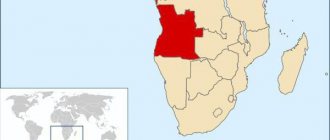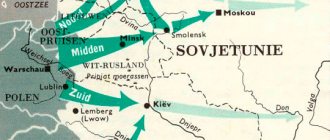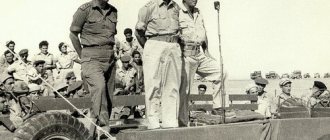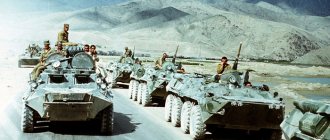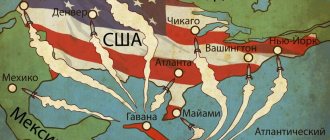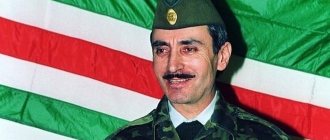- August 9, 2019
- Events
- Violetta Berezina
The Vietnam War (1954–1975) was a protracted, costly, and controversial conflict that pitted the communist government of North Vietnam and its allies in South Vietnam, known as the Viet Cong, against the government of South Vietnam and its main ally - United States. It was intensified by the ongoing Cold War between the United States and the Soviet Union. More than 3 million people (including more than 58,000 Americans) died during the Vietnam War, more than half of them civilians living in Vietnam.
Opposition to the war in the United States divided American society even after President Richard Nixon ordered the withdrawal of troops in 1973. Communist forces ended the war by taking control of South Vietnam in 1975, and the country was unified into the Socialist Republic of Vietnam the following year.
Origins of the conflict
Vietnam, a country located in Southeast Asia on the eastern edge of the Indochina Peninsula, has been under French colonial rule since the 19th century. During World War II, Japanese troops invaded its territory. To fight the Japanese occupiers and the French colonial administration, political leader Ho Chi Minh, inspired by Chinese and Soviet communism, created the Viet Minh, or Vietnamese Independence League.
After defeat in World War II, Japan withdrew its troops, leaving the French-installed Emperor Bao Dai as ruler. Seeing the possibility of seizing control of the country, forces led by Ho Chi Minh rebelled and the northern city of Hanoi was captured. At the same time, the Democratic Republic of Vietnam (DRV) was created with Ho as president. Seeking to regain control of the region, France supported Emperor Bao and created the state of Vietnam in July 1949, with Saigon as its capital.
Both sides sought the same thing: the unification of the country. But while Ho and his supporters aimed to create a communist state, Bao and many others sought to establish close economic and cultural ties with the West.
Vietnam War figures
Total US combat losses - 47,378 people, non-combat - 10,799. Wounded - 153,303, missing - 2,300. About 5 thousand US Air Force aircraft were shot down. Losses of the army of the puppet Republic of Vietnam (US ally) - 254 thousand people. Combat losses of the Vietnamese People's Army and partisans of the National Liberation Front of South Vietnam - more than 1 million 100 thousand people. Vietnamese civilian casualties - more than 3 million people. 14 million tons of explosives were detonated, which is several times more than during World War II in all theaters of combat. US financial costs - 350 billion dollars (in current equivalent - more than 1 trillion dollars). Military-economic assistance to the DRV from China ranged from $14 billion to $21 billion, from the USSR - from $8 billion to $15 billion. There was also assistance from Eastern European countries, which at that time were part of the Soviet bloc.
Beginning of the Vietnam War
It is officially believed that it began in 1954, although the conflict in the region had not subsided for a decade. After Ho's communist forces took power in the north, armed conflict between the northern and southern armies continued until the decisive battle of Dien Bien Phu ended in victory for North Vietnamese forces in May 1954. The war ended with the defeat of the French, which marked the end of almost a century of their colonial rule in Indochina.
A subsequent treaty, signed in July 1954 at a conference in Geneva, divided Vietnam along a latitude known as the 17th parallel (17 degrees north latitude), with Ho controlling the northern part and Bao the southern. The treaty also provided for national elections to be held in 1956 on the issue of reunification.
However, in 1955, anti-communist politician Ngo Dinh Diem removed Emperor Bao from power and, having proclaimed a republic, became president of the government of the Republic of Vietnam, which in that era was often called South Vietnam.
Ho Chi Minh Trail
The Ho Chi Minh Trail is a system of mostly camouflaged narrow dirt roads that was built and used by North Vietnam during the Vietnam War to supply weapons, food, and fuel to the National Liberation Front of South Vietnam. Officially, it was called the Truong Son Strategic Road or Highway No. 559. Both the Vietnamese and the Americans began to call it the Ho Chi Minh Trail. It first passed through North Vietnam, then, not far from the 17th parallel, it went to Laos, and continued on the territory of Cambodia (Ho Chi Minh had a strong position in these countries, since from 1930 to 1951 there was a single Communist Party of Indochina, of which he was the leader appeared). From the territory of these countries there were already several branches to South Vietnam.
Vietnam War Poster
The Cooper-Church Amendment prohibited American ground forces from crossing the border into Laos and Cambodia. Despite this, the US army and intelligence agencies carried out raids in Cambodia and waged a so-called “secret war” in Laos.
At first, a stream of porters moved along the Ho Chi Minh Trail, delivering not only light weapons, but also dismantled artillery pieces and mortars. Then elephants tamed by the locals appeared. Subsequently, they began to attach loads to bicycles, and then cars and tanks walked along it. By 1965, the Ho Chi Minh Trail was a system of several parallel roads. More and more complex engineering structures appeared on it: crossings, bridges, fords invisible from airplanes. Where the road passed through treeless areas, trees were planted for camouflage. Telephone communication was established for 6 thousand subscribers.
The NLF (Viet Cong) could not operate without supplies from the North, which were carried along the Ho Chi Minh Trail. Realizing this, the command of the American contingent in Vietnam considered the destruction of the “Trail” to be one of its main tasks. American reconnaissance planes and helicopters flew over it around the clock, and the bombing did not stop for a day. The US Air Force made 800 thousand sorties and dropped 3 million tons of bombs. Seismic sensors were dropped to record the movement of trucks along the road, as well as ball and fragmentation bombs, and magnetic bombs to destroy moving vehicles. The jungle through which the road passed was watered with defoliants. The most important crossroads were attacked by paratroopers of the American 1st Airborne Division and the South Korean White Horse Division. Hundreds of helicopters took part in the attacks. Over five years, the US Air Force flew 2,602 missions only to drop 47,409 containers of silver iodide onto the clouds in order to cause rain and flood the Trail, as well as cause rivers to rise and destroy crops. This project was called "Spinach". It is no coincidence that in the late 60s and early 70s, that is, at the very height of the war, the greatest precipitation was recorded for the entire period of observation. After American bombers raided the “Trail,” teams of Vietnamese repairmen (mostly girls) quickly filled up the craters.
The United States lost 2,545 aircraft of various types over the Ho Chi Minh Trail (in total, 5 thousand aircraft and countless helicopters were shot down). Because of the “Trail”, part of which passed through the territory of Laos, this country also suffered. The Americans bombed its territory very intensively. In addition, the huge B-52s, which took off from Clark Field, the largest US Air Force base in the Philippines at that time, by their very design were not suitable for landing with a full load of ammunition. In rainy weather, when they had no targets in North Vietnam, the Flying Fortresses simply disposed of the bombs over Laos before landing in Thailand, not caring where they landed. From 1964 to 1972, 2.5 million tons of bombs were dropped on Laos, more than on Nazi Germany in World War II.
By the beginning of the final offensive on Saigon in 1975, the construction of an oil pipeline to the South was even completed to quickly supply combat vehicles with fuel.
Since 1961, a secret shipping line called the Ho Chi Minh Trail to the Sea has operated. Along it, weapons and other military equipment for the partisans were also delivered to the South on cargo ships. For its operation, a separate fleet was created, consisting mainly of medium-tonnage vessels. In addition to transporting goods, this fleet participated in the liberation of the islands and even transported political prisoners who managed to escape from the prison of Con Dao Island. There were no numbers or names on the sides of the ships. Some even disguised themselves as foreign ships.
Currently, some parts of the Ho Chi Minh Trail are a tourist attraction, others are used for travel by car and motorcycle, and others, remote ones, are covered with jungle and wild animals roam through them again.
Vietcong
As the Cold War intensified, the Americans tightened their policies toward all Soviet allies, and in 1955, President Dwight D. Eisenhower pledged his strong support to Diem and South Vietnam.
With training and equipment provided by the US military and the CIA, Diem's security forces cracked down on sympathizers of Ho Chi Minh's organization, the Viet Minh, in the south. He mockingly called them Viet Cong (Vietnamese communists). In total, about 100,000 people were arrested, many of them tortured in prison or executed.
By 1957, the Viet Cong and other opponents of Diem's repressive regime began resistance, which included attacks on government officials and other targets, and by 1959, they began skirmishes involving soldiers from the South Vietnamese Army.
In December 1960, many of Diem's opponents in South Vietnam, not only the communists, created the National Liberation Front (NLF) to organize resistance to the regime. Although its members claimed to be autonomous and most were not communists, many in Washington believed that the organization was essentially a puppet of Hanoi.
Strategic acquisitions
Below is a brief summary of the results of the Vietnam War from the point of view of strategic acquisitions. During the long war, the Americans had to create a powerful structure for the maintenance and repair of military equipment. Repair complexes were located in South Korea, Taiwan, Okinawa and Honshu. The Sagama Tank Repair Plant alone saved the US Treasury approximately $18 million.
All this could allow the American army to enter into any military conflict in the Asia-Pacific region without worrying about the safety of military equipment, which could be restored and used again in battle in a short time.
Domino theory
A team sent by President John F. Kennedy in 1961 to report on conditions in South Vietnam recommended increased American military, economic and technical assistance to help Diem counter the Viet Cong threat.
Acting on the "domino theory" that if one Southeast Asian country became communist, many others would be inspired by its example, Kennedy increased US aid, although he stopped short of committing large-scale military intervention.
By 1962, the US military presence in South Vietnam was approximately 9,000 troops, compared with less than 800 in the 1950s.
Gulf of Tonkin
A coup d'état of some of his generals succeeded in overthrowing and killing Diem and his younger brother Ngo Dinh Nu in November 1963, three weeks before Kennedy was assassinated in Dallas, Texas. The ensuing political instability in South Vietnam convinced Kennedy's successor, Lyndon B. Johnson, and Secretary of Defense Robert McNamara to further increase U.S. military and economic support.
In August 1964, after DRV torpedo boats attacked two American destroyers then in the Gulf of Tonkin, Johnson ordered a retaliatory strike against North Vietnamese military targets. Some time later, Congress passed the Gulf of Tonkin Resolution, which gave Johnson broad war powers, and the following year American planes began regular bombing campaigns, codenamed “Piercing Arrow.”
In March 1965, Johnson, with the support of the American public, decided to send US combat forces to fight in Vietnam. By June of that year, 82,000 troops were stationed in Vietnam, and by the end of 1965, military leaders had called up an additional 175,000 troops to support the embattled South Vietnamese Army.
Despite the concerns of some of his advisers about this escalation and all the military activity in the growing anti-war movement, Johnson's decision sent 200,000 troops in stages over two years. In addition, a number of troops were contributed by South Korea, Thailand, Australia and New Zealand.
Causes
When thinking about the causes of the Vietnam War, it is difficult to escape the patterns. The roots of any war must be sought in the answer to the question: “Who benefits from this?” For the domestic audience of the United States, its citizens brought the light of democracy to the uncouth natives. However, even today Americans “save” the inhabitants of Iraq, Libya, and Syria from ignorance. And we all remember well how they “helped” the people of Yugoslavia to understand all the “beauty” of democratic values.
The Vietnam War was a period of fierce confrontation between two ideologies. Vietnam at that time was divided into two parts. The liberation movement in North Vietnam was supported by the USSR, and South Vietnam was a US protectorate. The precursors to war are often internal contradictions in a country, and Vietnam was no exception. For a long time it was a French colony. The liberation movement for independence in the country began in the 40s of the last century. An interesting fact is that the leader of the movement against the French colonialists, Ho Chi Minh, was actively supported by the United States during World War II. It was beneficial for the Americans that the Vietnamese Independence League, which he headed, was fiercely fighting the Japanese. At that time, “Grandfather Huo” was fighting in China. The Americans spared no money on weapons for the Chinese and Vietnamese communists, with whose hands the enemies of the United States were destroyed.
The situation changed after the Japanese surrender. Ho Chi Minh with troops of his supporters captured Hanoi and moved on, spreading his influence over increasingly vast territories of North Vietnam. Not wanting to lose its influence in Indochina, in December 1946 France transferred its expeditionary force there, but was unable to do anything against the growing strength of Ho Chi Minh's partisan detachments.
And already in 1950, the United States came to the aid of France. And they got involved in this long war. They were terrified of the spread of communist influence in Asia, so the States already at that time paid for 80% of all military expenses. These were terrible years in the history of Vietnam. Tourists who decide to visit Hanoi will learn about this terrible time by visiting the Hoa Lo prison museum.
The museum is conveniently located in the historical part of the city, between the central railway station and the Lake of the Returned Sword. Part of the museum's exhibition tells about the torture that Vietnamese fighters against the French colonialists were subjected to. During the period of 1954 alone, more than 2 thousand people were kept and brutally tortured in the Hoa Lo prison. The cruelty of “civilized” people is amazing.
It’s hard to imagine, but the history of long-suffering Vietnam could have been even more tragic. It is known that Vice President Richard Nixon recommended destroying the Vietnamese with tactical nuclear weapons. Memories of the nuclear bombing of Japan were still fresh. in July 1954 prevented this bloody madness from being carried out . In accordance with it, Vietnam was divided along the demilitarized zone (17-1 parallel) into North and South Vietnam. Losing their influence, the French almost immediately granted independence to South Vietnam.
For a short time, active military operations in Vietnam subsided. During this period, an outright “witch hunt” began overseas in the United States. Communist ideology becomes banned; the United States views any event in the world through the prism of its own security, as is customary today. In the case of Vietnam, this played a fatal role. The spread of communism in China, and then in North Vietnam, was perceived by the US administration as a threat to a complete loss of influence in Asia.
France, having lost its strength, could no longer hold back the onslaught of the northerners, and the Americans decided to replace them. They provided universal support to the first president of South Vietnam, Ngo Dinh Diem. The Vietnamese associate this personality with the times of rabid dictatorship and persecution of Buddhism. Today, all tourists visiting the sights of Hue are shown the car in which the Buddhist monk Thich Quang Duc went to Saigon and committed self-immolation. So he protested against the persecution of Buddhism. A recording of this tragic event has been preserved.
Ngo Dinh Diem's brutal rule predictably led to the formation of a resistance in South Vietnam. Multiple South Vietnamese guerrilla groups united in December 1960 to form the National Liberation Front of South Vietnam, called the Viet Cong in the West.
The Americans could not allow the Viet Cong to unite with the northern troops. This would mean the fall of the regime of Ngo Dinh Diem, loyal to the Americans. In December 1961, US military forces arrived in South Vietnam, consisting of two helicopter companies.
In our minds it is customary to associate the image of John Kennedy almost with a “dove of peace.” However, this image is far from reality. It was his administration that frantically demonstrated to the USSR its determination in the matter of destroying the “communist infection.” American advisers trained the South Vietnamese military in the basics of counterinsurgency. The situation in the country was heating up. The threat of losing South Vietnam, and with it Laos, Thailand, and Cambodia, was already too realistic. The blame for the sluggishness of the military was attributed to the inability to fight and the excessive greed of Ngo Dinh Diem.
Predictably, on November 2, 1963 , under murky circumstances, Ngo Dinh Diem was shot and killed. There was a coup in the country, of which there were several more in the next two years.
By a fateful coincidence, at the same time, US President John Kennedy was shot, and Lyndon Johnson took his place. The first document he signed was an order to send additional troops to Vietnam. Thus, the limited contingent of American troops from 760 people in 1959 increased to 23,300 in 1964. The flywheel of the war began to spin with renewed vigor. From this moment we can consider that the “hot” phase of the confrontation between the two systems began.
Now all that remained was to wait for a formal reason and unleash a full-scale bloodbath. This occasion was the shelling of the American destroyer Maddox by North Vietnamese troops, which, together with two other American ships, arrived in the Gulf of Tonkin on August 2, 1964 Later, information about the shelling was refuted by the sailors of the destroyer themselves. But who cared anymore? Isn’t it true, there is a direct analogy with today. For example, with unconfirmed information on the “uranium dossier”, which formed the basis for the decision to start the war in Iraq.
Lyndon Johnson immediately ordered airstrikes against North Vietnam (Operation Pierce Arrow). The US Congress adopted the Tonkin Resolution almost unanimously. There was only one vote against. Ordinary Americans were not at all excited by the news of the start of a military operation. Then none of them imagined that they would have to die on foreign soil. It’s one thing when “you need to unite the nation and defend democracy,” and quite another to die.
of February 1968, the US military contingent in Vietnam already numbered more than half a million people. The Vietnamese fought desperately for their right to life. When coffins began to arrive in the United States, the wave of anti-war sentiment began to grow exponentially. The war came into the homes of ordinary Americans.
Against the backdrop of significant defeats in South Vietnam and the virtual failure of the “air” war, in the spring of 1968, negotiations began on a cessation of hostilities. Then events began to occur that today are commonly called the use of “double standards.” Publicly, the American administration announced a policy of withdrawing American soldiers from the territory of South Vietnam and even returned home 210 thousand of its troops. In fact, the bet was placed on arming the Saigon army, which by that time numbered more than a million people. She was given modern American weapons.
When Richard Nixon, in the heat of his presidential promises, announced an end to the war in 1969, it was enthusiastically received by American society. The people had a short memory, because Lyndon Johnson lied just as sweetly. One way or another, Nixon was elected president. The coffins in which young boys from distant Vietnam were returning home quickly discouraged Americans from carrying “democratic values,” and discontent in the country grew.
At the same time, American bombers dropped more bombs on Vietnam in 1970 than in the last five years combined. All public statements of American politicians turned out to be lies.
Appetite, as you know, flares up during eating. It was no longer possible to stop the war when it brought such dividends. Weapons corporations had a vested interest in the supply of weapons. The fire of napalm and phosphorus burned out entire villages. Dioxin was used, the most toxic substance at that time. You can learn more about the history of this hell at the Hanoi War Crimes Museum. The photo and film documents collected there are terrifying. In Vietnam, children are still born with genetic deformities.
It is now known that during the entire conflict, 14 million tons of explosives were dropped on Vietnam. The American political and economic elite made billions of dollars from this tragedy. Maybe that's why the war lasted so endlessly.
Under the pressure of internal unrest, exhausted by large material and human losses, at the beginning of 1973 the United States was forced to end the war. The active phase of American participation in the war ended in inglorious flight. But military and material assistance to the Saigon regime continued until 1975, until its final defeat.
William Westmoreland
In contrast to the air attacks on North Vietnam, military operations by the American and South Vietnamese armies in the south of the country were conducted primarily locally, under the command of General William Westmoreland, who coordinated his actions with the government of General Nguyen Van Thieu in Saigon.
Westmoreland pursued a policy of attrition, seeking to kill as many enemy troops as possible rather than attempting to secure territory. By 1966, large areas of South Vietnam were designated "free fire zones" from which all innocent civilians were to be evacuated, leaving only the enemy. Constant B-52 bombing and strafing left these areas uninhabitable as refugees lived in camps in designated areas near Saigon and several other cities.
Even as enemy casualties (sometimes exaggerated by American and South Vietnamese officials) mounted steadily, DRV and Viet Cong troops refused to stop fighting, encouraged by the fact that they could easily retake lost territory thanks to the manpower and supplies brought through Cambodia and Laos. In addition, with support from China and the Soviet Union, North Vietnam strengthened its air defense capabilities.
Participation in the conflict between the USSR and China
Military, political and economic assistance from the USSR to North Vietnam played a significant role in the outcome of the war. Supplies from the Soviet Union took place through the port of Haiphong, which transported equipment and ammunition, tanks and heavy weapons to the Viet Cong. Experienced Soviet military specialists who trained the Viet Cong were actively involved as consultants.
China was also interested and helped the northerners by supplying food, weapons, and trucks. In addition, Chinese troops numbering up to 50 thousand people were sent to North Vietnam to restore roads, both automobile and railway.
Anti-war protests
By the end of the autumn of 1967, there were already about 500,000 military personnel here, and losses in the United States reached more than 15,000 killed and more than 100,000 wounded. As the war continued, some soldiers began to question the government's reasons for keeping them there, as well as Washington's repeated claims that the war was won.
In the final years of the war, the physical and mental health of American soldiers deteriorated significantly, in particular due to drug use, post-traumatic stress disorder (PTSD), mutinies and attacks by soldiers on officers.
From the summer of 1966 until 1973, there were mass desertions, and the rise of the anti-war movement led to violent protests, assassinations, and mass arrests of personnel stationed in Vietnam as well as in the United States.
Stunned by the war reports, Americans on the home front also began to protest: in October 1967, some 35,000 demonstrators staged a massive protest outside the Pentagon. Opponents of the Vietnam War argued that the primary casualties were civilians, not enemy soldiers, and that the United States supported Saigon's corrupt dictatorship.
Consequences
The greatest losses in this war were suffered by the civilian population of Vietnam, both its southern and northern parts. South Vietnam was flooded with American defoliants; in northern Vietnam, as a result of many years of bombing by American aircraft, many residents were killed and infrastructure was destroyed.
After the US withdrawal from Vietnam, many American veterans subsequently suffered from mental disorders and various types of illnesses caused by the use of dioxin contained in Agent Orange. The American media wrote about an increased suicide rate among Vietnam War veterans compared to the US average. But official data on this matter have not been published. Representatives of the American political elite fought in Vietnam: former Secretary of State John Kerry, many senators at different times, including John McCain, presidential candidate Al Gore. At the same time, shortly after returning from Vietnam to the United States, Kerry participated in the anti-war movement. One of the former presidents, George W. Bush, avoided Vietnam because he served in the National Guard at the time. His campaign opponents portrayed it as a way of shirking his duty. However, this biographical fact rather indirectly served him well. Some American political scientists have concluded that any participant in the Vietnam War, regardless of his qualities, has no chance of becoming president - the negative image of this war is so entrenched in the voter.
Since the end of the war, quite a lot of films, books and other works of art have been created based on it, most of them in America.
Tet Offensive
Already in late 1967, the Vietnamese communists began to become impatient and sought to strike a decisive blow aimed at forcing the United States to abandon hopes of a successful conclusion. On January 31, 1968, some 70,000 DRV soldiers under the command of General Vo Nguyen Giap launched the Tet Offensive, a coordinated series of brutal attacks on more than 100 cities and towns in South Vietnam. Caught by surprise, American and South Vietnamese forces nevertheless managed to react quickly, and the Communists were unable to hold any of the objectives for more than a day or two.
However, reports of the Tet Offensive stunned the US public, especially after news emerged that Westmoreland had requested an additional 200,000 troops, despite repeated assurances that victory in the Vietnam War (1964–1975) was imminent. With his ratings falling in an election year, Johnson called for an end to bombing across much of the north.
Johnson's new tactics met with a positive response from Hanoi, and peace talks began in Paris in May. Despite the later inclusion of the South Vietnamese, no agreement could be reached, and the 1968 presidential race was won by Republican Richard M. Nixon.
De-Americanization and the final stage of the war
At first, the American command intended to continue its offensive against the Viet Cong and bombard the road along which supplies were supplied from the north to South Vietnam. At the same time, on the one hand, the American military wanted to take advantage of the defeat inflicted on the Vietnamese during the counteroffensive against them, and on the other hand, the very fact of the large-scale offensive undertaken by the Vietnamese led to greater caution in forecasting the results and timing of the proposed operations.
All this led to a re-evaluation of the entire policy in Vietnam by the US legislature and Congress. It turned out that based on the results of several years of war, it was impossible to conclude that its end was near. At the same time, the expenditures of the US state budget for all the years of the Vietnam War amounted to about one hundred and sixty-eight billion dollars. According to experts, this was a strong financial burden on the American economic system. Public support for President Johnson has diminished greatly.
As a result, the new President Richard Nixon, who came to power in 1968, decided to begin de-Americanization in Vietnam. This meant the gradual withdrawal of American military forces from the country. This process began in the summer of 1969. About fifty thousand soldiers were withdrawn from Vietnam every six months. As a result, by 1973, less than thirty thousand American troops remained in Vietnam.
In 1972, the Viet Cong armed forces carried out a three-pronged offensive, which resulted in the capture of a number of installations and several regions. The US military began bombing North Vietnam again to stop this offensive. Throughout 1972, negotiations took place to conclude a peace agreement.
As a result, the Paris Peace Treaty was reached in 1973. Under its terms, the American army had to withdraw from Vietnam. That same year, the American military left the country. The army of South Vietnam on its own could not cope with the offensive of the troops of North Vietnam, which at the end of April 1973 occupied the capital of South Vietnam, Saigon.
Vietnamization
Speaking about the Vietnam War (1964-1975), it is worth briefly dwelling on this policy. Nixon sought to provoke an anti-war movement. In an attempt to limit the number of casualties among his citizens, he announced a program called "Vietnamization": the withdrawal of American troops, increased aerial bombing and artillery, and the training and provision of weapons to the South Vietnamese.
In addition to these policies, Nixon continued public peace negotiations on the Vietnam War in Paris, adding secret high-level negotiations conducted by Secretary of State Henry Kissinger beginning in the spring of 1968.
The North Vietnamese insisted on the withdrawal of American troops and the removal of the US-backed Nguyen Van Thieu as terms of peace, and as a result the negotiations stalled.
"De-Americanization"
The US General Staff wanted to use the defeat of the Viet Cong to expand and consolidate the success. The generals demanded a new call for reservists and intensified bombing of the Ho Chi Minh Trail in order to further weaken the bloodless enemy. At the same time, the staff officers, taught by bitter experience, refused to outline a time frame and give any guarantees of success.
As a result, Congress demanded a re-evaluation of all US military actions in Vietnam. The Tet Offensive destroyed the hope of the citizens of the United States for a speedy end to the war and undermined the authority of President Johnson. Added to this was the enormous burden on the US state budget and economy caused by the war - for the period 1953-1975. $168 billion was spent on the Vietnam campaign.
Due to the combination of all factors, Nixon, who became US President in 1968, was forced to announce a course towards the “de-Americanization” of Vietnam. Since June 1969, a gradual withdrawal of American troops from South Vietnam began - approximately 50 thousand people every six months. By the beginning of 1973, their number was less than 30 thousand people.
My Lai Massacre
In March 1968, American soldiers mercilessly killed more than 400 unarmed civilians in the village of My Lai. After this massacre, protests against the Vietnam War continued to grow. In 1968 and 1969, hundreds of protest marches and rallies took place across the country.
The following November, Washington hosted one of the largest anti-war demonstrations in American history, with more than 250,000 people calling for the withdrawal of American troops from Vietnam.
This movement caused disunity among Americans. Some young people perceived the Vietnam War (1965-1974) as a form of unchecked power. To other Americans, opposing the government was considered unpatriotic and treasonous.
As the first American troops withdrew, those who remained became increasingly bitter and disillusioned, exacerbating problems with morale and leadership. Tens of thousands of soldiers left their units without permission, and hundreds of thousands became “draft dodgers”; thousands fled to Canada, avoiding conscription. The draft ended in 1972, and the following year Nixon created a volunteer army to fight in the Vietnam War.
Tet battle
During the Vietnam War, American troops were recruited entirely through volunteers and a limited draft. President L. Johnson refused the partial mobilization and call-up of reservists, so by 1967 the human reserves of the American army were exhausted.
Meanwhile, the Vietnam War continued. In mid-1967, the military leadership of North Vietnam began planning a large-scale offensive in the south in order to turn the tide of hostilities. The Viet Cong wanted to create the preconditions for the Americans to begin to withdraw their troops from Vietnam and overthrow the government of Nguyen Van Thieu.
The United States was aware of these preparations, but the Viet Cong offensive came as a complete surprise to them. The northern army and guerrillas went on the offensive on Tet Day (Vietnamese New Year), when any military action is prohibited.
On January 31, 1968, the North Vietnamese army launched massive attacks throughout the South, including major cities. Many attacks were repulsed, but the South lost the city of Hue. Only in March was this offensive stopped.
During the 45 days of the North's offensive, the Americans lost 150,000 soldiers, more than 2,000 helicopters and airplanes, more than 5,000 pieces of military equipment and about 200 ships.
At the same time, America was waging an air war against the DRV (Democratic Republic of Vietnam). About a thousand aircraft took part in the carpet bombings, which during the period from 1964 to 1973. flew more than 2 million combat missions and dropped approximately 8 million bombs in Vietnam.
But the American soldiers miscalculated here too. North Vietnam evacuated its population from all major cities, hiding people in the mountains and jungles. The Soviet Union supplied the northerners with supersonic fighters, air defense systems, radio equipment and helped them master it all. Thanks to this, the Vietnamese managed to destroy about 4,000 US aircraft throughout the years of the conflict.
The battle of Hue, when the South Vietnamese army wanted to recapture the city, was the bloodiest in the entire history of this war.
The Tet Offensive caused a wave of protests among the US population against the Vietnam War. Then many began to consider it senseless and cruel. No one expected that the Vietnamese communist army would be able to organize an operation of such a scale.
Shooting in Kent
In 1970, during a joint operation, US and South Vietnamese troops invaded Cambodia, hoping to destroy the DRV supply base located there. The South Vietnamese then led the invasion of Laos, but their troops were driven back by the North Vietnamese.
The invasion of these countries and violation of international law sparked a new wave of protests on college campuses across America. The result of one of these protests, which took place on May 4, 1970 at the University of Kent (Ohio), was the murder of four students who were shot by National Guardsmen. During another protest against the Vietnam War, 10 days later, police shot and killed two university students in Jackson, Mississippi.
The unsuccessful offensive against South Vietnam led to Hanoi agreeing to a compromise in late June 1972. Representatives of Kissinger and North Vietnam prepared a peace agreement within two months, but its terms did not suit Saigon, and in December of that year Nixon authorized bombing against targets in Hanoi and Haiphong. Known as the Christmas bombings, the raids drew international condemnation.
Background
Humanity is built in a strange way. Any inhabitant of the Earth understands that war is horror, misfortune and tears. A person, unless he is, of course, deeply ill, realizes that there is no place for romance in it. It is impossible to justify the death of civilians by any goals. There are no such goals! But at the same time, most of those living do not perceive the pain of millions of people as their own. The loss of a wallet is perceived more acutely than war, unless it concerns one personally. For this reason, events that took place several decades ago are of little interest to anyone. Especially if they took place in a country located thousands of kilometers away.
The problem is that history repeats itself. The trouble that engulfed distant Vietnam in the 70s of the last century has now reached other parts of the world. Can we be sure that it will not affect you and me?
When did the US war in Vietnam end?
January 1973 marked the end of open hostilities between the United States and North Vietnam. This happened after the final peace agreement was concluded. However, North and South Vietnam continued to fight each other until April 30, 1975, when the DRV captured Saigon, later renamed Ho Chi Minh City.
More than twenty years of violent conflict have taken a devastating toll on the country's population: after years of war, an estimated 2 million Vietnamese have been killed, 3 million injured, and another 12 million displaced as refugees. The war between Vietnam and America destroyed the infrastructure and economy of this Asian state. And the recovery process was very slow.
The country was unified into the Socialist Republic of Vietnam in 1976, although sporadic violence continued for 15 years after that, including conflicts with China and Cambodia.
In the United States, the consequences of the Vietnam War (1964-1975) reverberated for a very long time. The country spent more than $120 billion on the conflict from 1965 to 1973; These huge expenses caused inflation, which was aggravated by the global oil crisis of 1973 and the rapid rise in fuel prices.
The psychological consequences were even deeper. The Vietnam War (1965-1974) shattered the myth of American invincibility and divided the nation. Many returning veterans experienced backlash from not only opponents of the war (who viewed the soldiers as killing innocent civilians) but also their supporters (who viewed them as losers of the war), along with physical harm, including the effects of exposure to a toxic herbicidal agent .
In 1982, the Veterans Memorial was opened in Washington. It contains the names of 57,939 Americans who were killed or missing in action during the US-Vietnam War; later additions increased this number to 58,200.
Results
For more than 10 years, the Vietnamese resisted desperately and heroically. You need to understand that it is impossible to win such a war on the will to win alone. It was a strange war in which millions of Vietnamese were killed and maimed, but it was actually fought between two political systems. The USSR and China sided with the communist North. The support was enormous. Free material assistance was provided, weapons were supplied, and our military advisers trained the Vietnamese military. Without their help, victory would have been impossible.
The Second Indochina War between Vietnam and the United States ended only in April 1975, when the Saigon Independence Palace was captured. Later the country was unified.
The Vietnamese are proud of their heroic history. While it was both a civil war, it was also a time of liberation from American occupation. The country defended its right to its own choice and sovereignty. Millions of maimed Vietnamese, in some places completely destroyed cities, fields and forests scorched by napalm - this is the price of that terrible war. But the country survived.
Today, tourists arriving in Vietnam are no longer reminded of the terrible and tragic pages of that very recent war. The country is actively developing. Young people are learning English in droves and are eagerly trying to help the crowds of vacationers who come to soak up the beautiful sandy shores of the South China Sea.
History buffs, tired of beach holidays, book excursions where they are willing to show them partisan tunnels and traps. Such excursions evoke ambivalent feelings. On the one hand, respect and admiration for the tenacity and courage of the people who endured a war to destroy the country for 10 years and emerged victorious from this massacre. On the other hand, the touch of commerce in everything is striking. A certain dissonance is felt in this country - patriotic posters are hung everywhere, on which “Grandfather Ho” is smiling, the pioneers wear red ties... But at the same time, there is universal admiration for the “green piece of paper”. A clear association emerges with the USSR during its collapse, and a sense of an impending era of change is felt.
For the United States, the war with the Vietnamese people became an inglorious and bitter page in history. The losses of the American army amounted to more than 60 thousand killed, over 300 thousand Americans were maimed. In addition, more than $4 billion was spent from the country's budget to help the Saigon regime. The war was a successful investment and a profitable event only for the “top”, which became quite rich during the 10 years of bloody carnage.
Conviction in one’s own exclusivity and the lack of alternative to the American development model, and most importantly, impunity. This is what lies at the heart of the Vietnam War.


